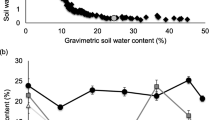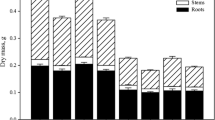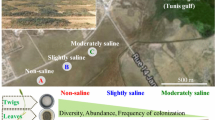Abstract
The ability to survive freezing and thawing is a key factor for the existence of life forms in large parts of the world. However, little is known about the freezing tolerance of mycorrhizal fungi and their role in the freezing tolerance of mycorrhizas. Threshold temperatures for the survival of these fungi have not been assessed experimentally. We grew isolates of Suillus luteus, Suillus variegatus, Laccaria laccata, and Hebeloma sp. in liquid culture at room temperature. Subsequently, we exposed samples to a series of temperatures between +5°C and −48°C. Relative electrolyte leakage (REL) and re-growth measurements were used to assess the damage. The REL test indicated that the lethal temperature for 50% of samples (LT50) was between −8.3°C and −13.5°C. However, in the re-growth experiment, all isolates resumed growth after exposure to −8°C and higher temperatures. As many as 64% of L. laccata samples but only 11% in S. variegatus survived −48°C. There was no growth of Hebeloma and S. luteus after exposure to −48°C, but part of their samples survived −30°C. The fungi tolerated lower temperatures than was expected on the basis of earlier studies on fine roots of ectomycorrhizal trees. The most likely freezing tolerance mechanism here is tolerance to apoplastic freezing and the concomitant intracellular dehydration with consequent concentrating of cryoprotectant substances in cells. Studying the properties of fungi in isolation promotes the understanding of the role of the different partners of the mycorrhizal symbiosis in the freezing tolerance.




Similar content being viewed by others
References
Bigras F, Dumais D (2005) Root-freezing damage in the containerized nursery: impact on plantation sites—a review. New For 30:167–184 doi:10.1007/s11056-005-4423-6
Corbery Y, Le Tacon F (1997) Storage of ectomycorrhizal fungi by freezing. Ann Sci For 54:211–217 doi:10.1051/forest:19970208
Crowe JH (2007) Trehalose as a “chemical chaperone”: facts and fantasy. Adv Exp Med Biol 594:143–158 doi:10.1007/978-0-387-39975-1_13
France RC, Cline ML, Reid CPP (1979) Recovery of ectomycorrhizal fungi after exposure to subfreezing temperatures. Can J Bot 57:1845–1848 doi:10.1139/b79-231
Frey-Klett P, Garbaye J, Tarkka M (2007) The mycorrhiza helper bacteria revisited. New Phytol 176:22–36 doi:10.1111/j.1469-8137.2007.02191.x
Heinonen-Tanski H, Holopainen T (1991) Maintenance of ectomycorrhizal fungi. Methods Microbiol 23:413–422 doi:10.1016/S0580-9517(08)70188-0
Karlsson PS, Nordell KO (1996) Effects of soil temperature on the nitrogen economy and growth of mountain birch seedlings near its presumed low temperature distribution limit. Ecoscience 3:183–189
Laiho O, Mikola P (1964) Studies on the effect of some eradicants on mycorrhizal development in forest nurseries. Acta For Fenn 77:1–34
Lindström A, Nyström C (1987) Seasonal variation in root hardiness in container-grown Scots pine, Norway spruce, and lodgepole pine seedlings. Can J Res 8:787–793 doi:10.1139/x87-126
Makkonen K, Helmisaari H-S (2001) Fine-root biomass and production in Scots pine stands in relation to stand age. Tree Physiol 21:193–198
Mason PA (1980) Aseptic synthesis of sheathing (ecto-) mycorrhizas. In: Ingram DS, Helgeson JP (eds) Tissue culture methods for plant pathologists. Blackwell Scientific, Oxford, pp 173–178
Moser M (1958) Der Einfluss tiefer Temperaturen auf das Wachstum und die Lebenstätigkeir höherer Pilze mit speziell Berücksichtung von Mycorrhizapilzen. Sydowia 12:386–399
Niederer M, Pankow W, Wiemken A (1992) Seasonal changes of soluble carbohydrates in mycorrhizas of Norway spruce and changes induced by exposure to frost and desiccation. Eur J Forest Pathol 22:291–299 doi:10.1111/j.1439-0329.1992.tb00796.x
Nylund J-E (1987) The ectomycorrhizal infection zone and its relation to acid polysaccharides of cortical cell walls. New Phytol 106:505–516
Quamme HA (1995) Deep supercooling in buds of woody plants. In: Lee RE Jr, Warren ja GJ, Gusta LV (eds) Biological ice nucleation and its applications. The American Phytopathological Society, Minnesota
Radoglou K, Cabral R, Repo T, Hasanagas N, Sutinen M-L, Waisel Y (2007) Appraisal of root leakage as a method for estimation of root viability. Plant Biosyst 141(3):443–459 doi:10.1080/11263500701626143
Räisänen M, Repo T, Lehto T (2007) Cold acclimation was partially impaired in boron deficient Norway spruce seedlings. Plant Soil 292:271–282 doi:10.1007/s11104-007-9223-7
Repo T, Lappi J (1989) Estimation of standard error of impedance-estimated frost resistance. Scand J For Res 4:67–74
Sutinen M-L, Ritari A, Holappa T, Kujala K (1998) Seasonal changes in soil temperature and in the frost hardiness of Scots pine (Pinus sylvestris) roots under subarctic conditions. Can J Res 28:946–950 doi:10.1139/cjfr-28-6-946
Szyrmer W, Zawadzki I (1997) Biogenic and anthropogenic sources of ice-forming nuclei: a review. Bull Am Meteorol Soc 78:209–228 doi:10.1175/1520-0477(1997)078<0209:BAASOI>2.0.CO;2
Tibbett M, Sanders FE, Cairney JWG (2002) Low-temperature induced changes in trehalose, mannitol and arabitol associated with enhanced tolerance to freezing in ectomycorrhizal basidiomycetes (Hebeloma spp.). Mycorrhiza 12:249–255 doi:10.1007/s00572-002-0183-8
Unestam T, Sun YP (1995) Extramatrical structures of hydrophobic and hydrophilic ectomycorrhizal fungi. Mycorrhiza 5:301–311 doi:10.1007/BF00207402
Wallander H, Nilsson LO, Hagerberg D, Bååth E (2001) Estimation of the biomass and seasonal growth of external mycelium of ectomycorrhizal fungi in the field. New Phytol 151:753–760 doi:10.1046/j.0028-646x.2001.00199.x
Acknowledgements
We thank Markus Eskelinen for help in the laboratory. The Erasmus student exchange programme made it possible for Arlena Brosinsky to participate in this work.
Author information
Authors and Affiliations
Corresponding author
Rights and permissions
About this article
Cite this article
Lehto, T., Brosinsky, A., Heinonen-Tanski, H. et al. Freezing tolerance of ectomycorrhizal fungi in pure culture. Mycorrhiza 18, 385–392 (2008). https://doi.org/10.1007/s00572-008-0190-5
Received:
Accepted:
Published:
Issue Date:
DOI: https://doi.org/10.1007/s00572-008-0190-5




